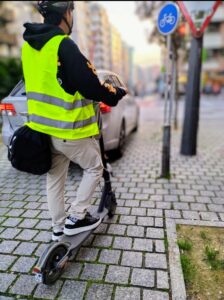Today, the Personal Mobility Vehicles (VMP) have revolutionized travel in urban environments. These VMPs range from electric scooters, electric scooters to skateboards, single axles with and without seats (segways) or hoverboards, and are designed for short journeys.
There is a basic regulations and some municipal regulations regarding its use, which can be consulted in the DGT website.
These vehicles provide many advantages when it comes to getting around, but they can also present some handicaps.
They are, for the most part, electrical, with which environmental impact is reduced considerably. They also improve mobility efficiency in areas where traffic tends to become congested. And it also represents an easily accessible transportation solution.
But they can also be more vulnerable to possible damage as they are built with substantially lighter materials, making the risks of falls and collisions greater. Furthermore, regulations have been surpassed by the rapid adoption of VMPs on the streets of our cities.
THE DGT informs us that Personal Mobility Vehicles (VMP) that are sold before January 21, 2024 may circulate until January 22, 2027 without certification. Therefore, all VMPs that are marketed from January 22, 2024 will be brands and models of VMPs that have been certified and will therefore appear in www.dgt.es/vmp.
He Royal Decree 970/2020, of November 10, which modifies the General Traffic Regulations and the General Vehicle Regulations in Spain, defines as vehicle Personal Mobility (VMP) still vehicle with one or more wheels with a single seat, powered exclusively by electric motors with batteries up to 100 VDC and charged Integrated up to 240 VAC input. These vehicles can reach speeds between 6 and 25 km/h (maximum), and can only have a seat or saddle if they are equipped with self-balancing systems.

This definition excludes vehicles for people with reduced mobility, toys, electric pedal-assist bicycles (EPAC) and vehicles classified as "L" according to EU Regulation 168/2013.
The VMPs, being driven solely by an electric motor, receive the Zero Emissions environmental classification and are exempt from displaying it visibly. A novelty of this regulation is that it not only establishes technical criteria for Personal Mobility Vehicles (VMP) intended for personal transportation, but also establishes standards for employees in the transport of goods and other services, detailing masses and dimensions.
VMP AND ROAD SAFETY
The recent decrease of 10% in the number of deaths on interurban roads and the decrease of 20% on urban roads in Spain, compared to 2019 data, reflects a progress in road safety. This achievement is attributed to joint efforts to improve infrastructure, implement control measures and raise awareness drivers and pedestrians.
However, he 81% increase in the number of pedestrians involved in accidents
with Personal Mobility Vehicles (VMP), going from 103 to 187 cases in one year,
put the urgent thing on the table need for more rigorous regulations and educational campaigns effective measures aimed at both drivers and pedestrians.
According to data from the DGT, 29.3% of the 2,189 victims with VMP were involved in accidents without the presence of another vehicle, while 52.1% were related to collisions with passenger cars. These numbers underscore the importance of focusing on the safety of VMP users and raising awareness about their coexistence safe with other means of transportation.
Although the general decrease in road accidents can be attributed in part to both regulations and technological advances in safety, the increase in accidents with MPVs raises the need to adapt to new mobility dynamics. Therefore, promoting safe coexistence between vehicles, VMPs and pedestrians will be essential.
Improving road safety and moving towards the goal of 0 victims implies a combination of strategies.
The implementation of more advanced technologies in vehicles, in addition to the continuous improvement of infrastructure, with clear signage and regular maintenance, contributes to preventing accidents.
Intensifying road safety education is essential for everyone. Therefore, both the specific campaigns
awareness and collaboration between authorities, manufacturers and society must be constant, to continue moving towards the desired goal of zero victims in the road.